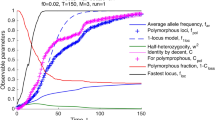Abstract
In this study, we simulated the process of the evolution of postmating isolation using three models in which postmating isolation is caused by (1) genetic divergence through collaborative coevolution, (2) genetic divergence through antagonistic coevolution resulting from sexual conflict, and (3) genetic divergence through combinational incompatibility. The collaborative coevolution model and the combinational incompatibility model showed a similar decreasing pattern of hybrid compatibility over generations depending on population size and mutation rates. The antagonistic coevolution model showed that reproductive isolation can evolve rapidly depending on the intensity of selection. In the combinational incompatibility model, the increasing number of loci that interact and result in incompatibility would have both promoting and inhibiting effects on the formation of hybrid incompatibility in the earlier stage of isolation. Mutation rates for genes causing incompatibility significantly affect the number of generations required for postmating isolation, which indicates that models assuming high mutation rates (e.g., μ = 10−4) might predict much faster evolution for reproductive isolation than those observed in real populations.
Similar content being viewed by others
Author information
Authors and Affiliations
Additional information
Received: January 29, 2001 / Accepted: July 4, 2001
Rights and permissions
About this article
Cite this article
Hayashi, T., Kawata, M. Evolution of postmating isolation: comparison of three models based on possible genetic mechanisms. Popul Ecol 43, 179–188 (2001). https://doi.org/10.1007/PL00012028
Issue Date:
DOI: https://doi.org/10.1007/PL00012028




